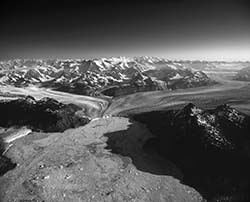Researchers working with the council have found what are believed to be the first documented freshwater springs found at the base of a tidewater glacier in Alaska.

This investigation was conducted by the Prince William Sound Science Center in support of ongoing council research focused on Columbia Glacier. Columbia Glacier has historically contributed to several maritime accidents related to the transportation of crude oil through Prince William Sound. The Glacier has been retreating rapidly from its terminal moraine near Heather Island since the early 1980s. Columbia Glacier’s main face is some 11 miles from Heather Island now. Icebergs produced by the glacier routinely cross into marine traffic lanes, posing a risk to crude oil tankers and their support vessels.
“The survey found several small freshwater springs in the bottom of the bay – places where fresh, clear water was seeping out of the bottom and mixing with the cloudier, saltier water of the bay, “ said Dr. Robert Campbell, researcher for the Prince William Sound Science Center.
